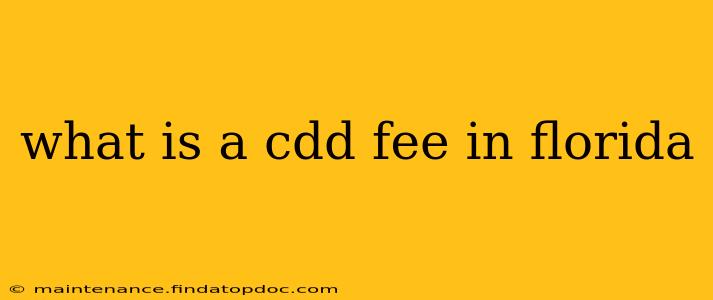A CDD fee, or Community Development District fee, is a one-time or recurring charge levied on property owners within a Community Development District (CDD) in Florida. These fees fund the ongoing maintenance and operation of infrastructure and amenities within the community. Understanding CDD fees is crucial for anyone considering buying property in a Florida community governed by a CDD. They significantly impact the overall cost of homeownership and should be carefully considered before making a purchase.
What does a CDD pay for?
CDD fees are used to cover a wide range of services and amenities designed to enhance the quality of life within the community. These can include:
-
Infrastructure Maintenance: This is often the largest portion of CDD fees. It covers the upkeep of roads, bridges, stormwater management systems, streetlights, and other essential infrastructure. Think of it as a specialized HOA, but focusing on larger-scale community infrastructure.
-
Amenity Maintenance: Many CDDs maintain recreational facilities like swimming pools, parks, playgrounds, fitness centers, and golf courses. The fees cover the staffing, maintenance, and upkeep of these amenities.
-
Landscaping and Irrigation: Maintaining the aesthetic appeal of the community through landscaping and irrigation systems is another common expense covered by CDD fees.
-
Security: Some CDDs provide security services such as patrolling or gated access, adding to the overall security and safety of the community.
-
Administrative Costs: The CDD also incurs administrative costs, including salaries for staff, legal fees, and other operational expenses.
Are CDD fees the same as HOA fees?
While both CDD fees and HOA fees contribute to maintaining a community, they are distinct. HOAs typically focus on the maintenance of individual homes and common areas within a smaller subdivision, whereas CDDs manage larger-scale infrastructure and amenities across a broader area, often encompassing multiple subdivisions. You can own a home subject to both a CDD and an HOA fee, resulting in higher overall homeowner costs.
How are CDD fees determined?
The amount of the CDD fee is determined by the CDD's budget, which is established annually. The budget reflects the costs associated with maintaining the infrastructure and amenities within the community. The fees are then assessed to property owners based on factors like lot size, property value, or a combination of both. Transparency is key; the CDD is obligated to provide detailed budget information to residents.
How are CDD fees paid?
CDD fees are typically paid annually, semi-annually, or even monthly, depending on the CDD's structure and financial policies. The payment process is usually straightforward, often handled through an online portal or by mail.
Can CDD fees increase?
Yes, CDD fees can increase over time. Factors such as inflation, necessary repairs, and upgrades to infrastructure or amenities can all lead to higher fees. Before purchasing a property within a CDD, it's crucial to review the CDD's financial statements and budget to understand the potential for future fee increases.
What happens if I don't pay my CDD fees?
Failure to pay CDD fees can result in liens being placed on your property, potentially leading to foreclosure. It is imperative to remain current on your CDD fee payments.
How can I find out about CDD fees before buying a home?
Your real estate agent should provide you with information about CDD fees associated with the property. You can also obtain detailed information directly from the CDD by reviewing their financial statements and budget. These documents are usually available on the CDD's website or by contacting the CDD management office.
Understanding CDD fees is essential to making an informed decision about buying a home in a Florida community governed by a CDD. By carefully reviewing the financial documents and asking relevant questions, you can ensure that you fully understand the associated costs and make an informed decision.
